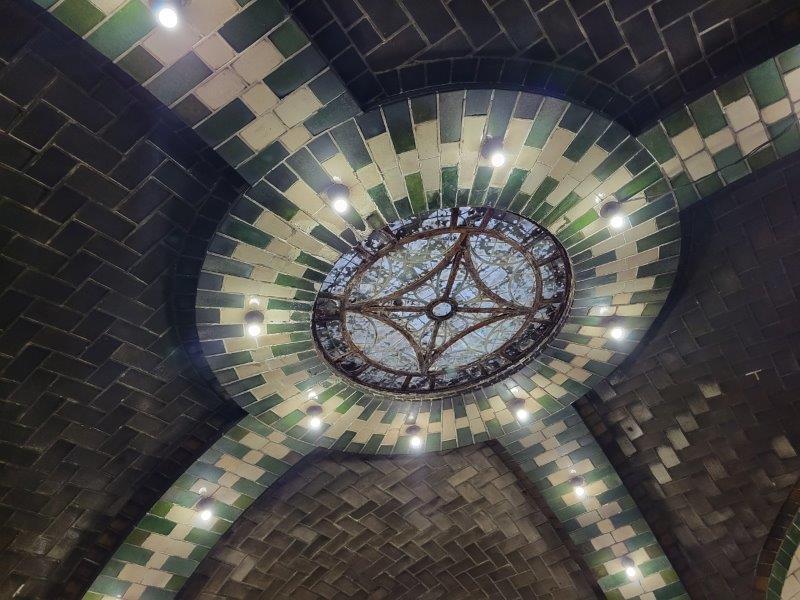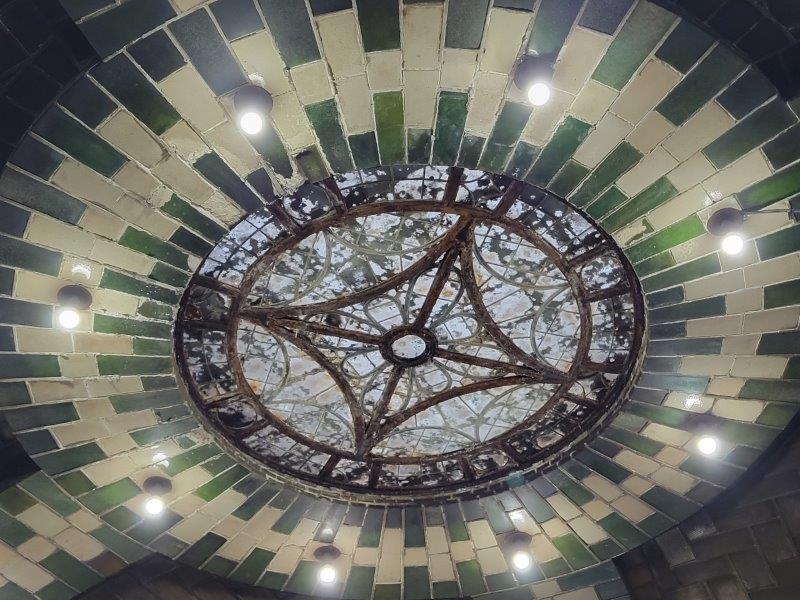The City Hall Subway Station is one of New York’s must stunning underground treasures, and it has been closed to the public since 1945. Actually visiting the abandoned City Hall Subway Station in New York is only permitted through tours organized by the New York Transit Museum, and the ticket for these tours is so prized that it has been recognized as being tougher to get than a a ticket for a Taylor Swift concert by NY Post. I was fortunate enough to score a ticket for one of these tours, and am thrilled to be among the few New Yorkers that have had the opportunity to visit what used one to the Jewel in the Crown of NYC’s subway stations.
The City Hall station is one of the original 28 subway stations of the New York City Subway. In keeping with the times when it opened, it has magnificent vaulted ceilings, stained glass skylights, tiles by Rafael Guastavino, who is the same tile maker as can be seen in Grand Central’s Whispering Gallery, chandeliers and a tightly curved track that loops around and is in use by the 6 subway line even today, despite the station being closed. This once-active station has transformed into an intriguing, hidden underground attraction that can be experienced by a lucky few on guided tours every year.
The City Hall Subway Station’s tightly curved platform, which was built to accommodate the shorter train cars that existed when it was built in 1904, leaves large gaps between the train and the platform for the longer subway cars that have become the norm, causing it to be closed down in 1945.

Table of Contents
History of Old City Hall Station
City Hall Station, located in lower Manhattan, was one of the first 28 subway stations that opened in New York City on October 27, 1904. It was part of the IRT Lexington line, and designed by Rafael Guastavino with his classic Guastavino tile that covers its high roof arches, which has survived its placement in an abandoned station and looks magnificent even today.
The City Hall Subway Station was very unlike the other stations with its elegant Romanesque Revival architectural style with a ceiling which consists of twelve Guastavino vaults, made of white tiles with green and brown tiles along the perimeter of each vault. Three of the vaults have leaded glass skylights that opened upward to vault lights in City Hall Park, which are slowly but surely coming apart as time goes on. Additional lighting was provided by twelve chandeliers hung from the center of the vaults, with floral motifs and nickel finishes, with exposed bulbs to showcase electricity, which was very much the fashion of the time as can be seen in the Grand Central chandeliers as well. The chandeliers near the skylights have five arms, while the others have four.

The very first subway ride in New York City commenced from City Hall Subway Station, kicking off what has become the lifeline of New York City. The station operated until 1945, when it had to be closed down as longer length of the newer subway cars meant the doors would open too far from the curved platform, making it unsafe for passengers to enter and exit the trains. The last City Hall train ran through this station on December 31, 1945.
City Hall Station has been recognized for its historical and architectural value, eventually acquiring landmark status in 1979. It truly is a throwback to the gilded age in New York, which can now only be accessed through tours organized by the New York Transit Museum.
Visiting City Hall Subway Station
The only way to visit the City Hall Station is through tours organized by the New York Transit Museum. Tickets are only available to members of the Museum, and the number of people covered in your membership can try to buy tickets to the City Hall Station tours. For instance, I signed up for a single membership, and that allowed me to buy one ticket for the City Hall Station tour.
Buying Tickets
Buying a ticket for the City Hall Subway Station Tour is a little bit more complicated than just being eligible for one. New York Transit Museum offers tickets for sale to their members three times a year at specified times for $50 a ticket for visitors 10 and older. You have to log in through your account, through very specific links that are emailed ahead of time, and be ready to hit the buy button as soon as the tickets go on sale as they sell out in minutes. I had to reset my password, which made me miss the first set of tickets I tried for, and then was ready for the second lot but did not go in through the designated links and missed out this chance as well. Third time was luckily the charm for me, and the stars aligned as I could get a ticket that was 3 months away.
The tickets are only intended for the members or names they specify as guests while buying them. Within 48 hours of buying your ticket, you need to email in your ID for a background check, and carry the same ID when you go for your tour. The tickets are not assignable, and the amount you paid is considered a donation if the person cannot make it for any reason at all. Our IDs were checked before the tour, so this is closely managed. This makes it impossible to buy a ticket second hand, or even to sell it as the hottest ticket in NYC.

There is a way to catch a sneak peek of the station by hiding on the downtown 6 subway train past its last stop, and catching a glimpse of the City Hall Subway Station as it loops around through the Abandoned City Hall Station to the other side of the track. After having visited the station through one of the New York Transit Museum tours, the sneak peek – which we got as we had to use the 6 train to enter and exit the station – is a very sad consolation prize indeed!
Here is a video of what the station looks like when viewed from the inside of a subway train, I took it on our way in and out of the station.
However, it is only a fraction of what you can see of the station from the platform as you can see in this video I took of a 6 subway train passing through the station while we were on the platform as part of the tour.
City Hall Subway Station Tour
The City Hall Subway Station Tours run for 90 minutes, though it can take months of planning to actually get to the point of attending one. It starts at Broadway and Warren Street, just inside the City Hall Park.
The City Hall Subway Station tour is a walking one, and visitors must be able to walk and navigate stairs to be able to attend. The guide communicates with everyone in the tour through headsets that are provided for use, which work well over and under ground. The guide, ours was Kristen, was very friendly, introduced herself to everyone before the tour, and was very knowledgeable and engaged in the 90 minutes we were on the tour.
The tour starts above ground, where we learnt about the history of the subway system and the areas around City Hall. We were shown the location of the original entrance to and the skylights we were going to experience in the City Hall Subway Station above ground, before we made our way to the downtown 6 track in the current Brooklyn Bridge-City Hall Station.

We got on the first train car of a downtown 6 train, which actually stopped at the City Hall Subway Station where a ramp had to be put up for us to enter the station. The guide walked us through the history of the station, and then gave us 10-15 minutes – it is easy to lose track underground – and then we caught a 6 train, which stopped especially for our tour at the station, back to the uptown 6 train station.

Old City Hall Subway Station
The City Hall Station, designed by Rafael Guastavino, is an architectural masterpiece featuring intricate details and elegant designs that are reflective of the gilded age it was built in. Its skylights that allow sunlight to filter into the space and its vaulted ceilings are unexpected in a subway station.
The architecture of the station features a series of Guastavino’s signature vaulted ceilings, which are embellished with ornamental tiles and patterns.



It is sad to see the skylights on the platform falling into disrepair with the station being abandoned, though their grandeur still shines through all the same. The location of these skylights was pointed out to us above ground at the start of the tour.

The City Hall Subway Station’s curved platform was designed to hug the train’s exterior, providing a seamless transition for passengers boarding and alighting. However, this platform did not work well with the newer, longer trains, making this unique design a disadvantage, eventually leading to the station’s closure.

Closing Thoughts
The Old City Hall Subway Station continues to be a jewel in New York’s crown, despite having been closed since 1945. Visiting it is out of reach for everyone except if you are lucky enough to score a ticket on a New York Transit Museum tour. The tickets are not transferable, and the only way you can get one is by becoming a member of the museum. It takes a lot of planning to visit, and is entirely worth the effort.




